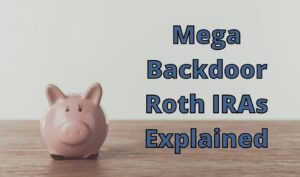
One of the main barriers to a large retirement account is the restriction on contributions. The IRS puts limits on the amount of capital you can contribute in any given year to your Roth IRA account. However, there is a way to get around this limit which is both completely legal and advised by many financial professionals.
This “Mega Backdoor” Roth IRA strategy will allow you to invest even more money into your Roth account than ever, and even bypass income restrictions on Roth IRA accounts. Best of all, it’s perfectly legal. Here’s how it works….
Why Choose a Roth Account?
Before we learn about the Mega Backdoor strategy, it’s essential to understand why a Roth IRA is beneficial in the first place. With a Roth account, you can contribute funds to your retirement on an after-tax basis. This differs from a Traditional IRA account in which contributions are made on a before-tax basis.
This means you don’t pay taxes on any Roth IRA withdrawals in retirement. That’s right– when it comes time to take distributions, any contributed capital and growth is not taxed at the time of withdrawal since it had already been taxed when it was contributed. This is a tax advantage for those who believe their tax rate at the time of retirement will exceed their tax rate today. (This makes sense for many people because they don’t expect to have a paycheck from a job during retirement, which lowers their income and, therefore, income taxes.)
One more benefit of a Roth IRA is that there are no required minimum distributions (RMDs). Therefore, your retirement account can continue to grow well into your retirement years. This makes a Roth IRA a great choice for many people seeking to use their retirement savings to build a legacy to leave to their heirs.
Roth Contribution Limits
While a Roth account might sound good to you right now, you must also understand its limitations. Like a Traditional IRA account, a Roth has an annual contribution limit (subject to change annually). However, unlike a Traditional IRA in which anyone can contribute regardless of income, a Roth account has income restrictions.
You can only contribute to a Roth IRA if you make less than a specified income level (subject to change annually; see 2025 IRA contribution limits for current information). Roth IRAs are also subject to contribution limitation based on your annual income… This is the reason more successful people don’t rely on Roth IRAs to build a legacy of wealth for themselves and their descendants. And that’s where the mega backdoor Roth IRA comes in handy.
What is a Mega Backdoor Roth IRA?
A Mega Backdoor Roth IRA allows you to invest in a Roth IRA account regardless of your income, effectively side-stepping the IRS income limitations on Roth IRAs. In fact, with the Mega Backdoor strategy, you can both max out your 401k plan and allocate up to an additional $39,500 in after-tax contributions to your new Roth IRA account. Don’t confuse a Mega backdoor Roth IRA with a standard backdoor Roth IRA (which is capped with annual contribution limits).
How is this possible? The Mega Backdoor can be used to allocate after-tax earnings in a 401k up to the employer contribution limit. This, combined with the employee contribution limit, gives you have the opportunity to invest as much as ten times the annual Roth IRA contribution limit!
No wonder it’s called the Mega Backdoor IRA!
Qualifying
 The first qualification step: you must use either your company’s 401k plan (if offered) or a Solo 401k plan if self-employed. Not only do you need to use these accounts to qualify for a Mega Backdoor Roth, but you must also max out employee contributions to these accounts and the employer contributions (if any).
The first qualification step: you must use either your company’s 401k plan (if offered) or a Solo 401k plan if self-employed. Not only do you need to use these accounts to qualify for a Mega Backdoor Roth, but you must also max out employee contributions to these accounts and the employer contributions (if any).
Suppose you don’t contribute the maximum yearly employee contribution to your 401k. In that case, you will not be able to take advantage of the Mega Backdoor strategy by contributing the employer limit with your after-tax dollars.
There are two more stipulations that your 401k account must allow for in order to qualify for a Mega Backdoor maneuver:
(1) Your 401k plan must allow for after-tax contributions to have the option of contributing more than the annual employee limit on your 401k. It is these after-tax contributions that will be used as capital to rollover into your Roth account. Without this ability, your opportunity for using a Mega Backdoor Roth is gone.
(2) Additionally, the 401k plan must allow for in-service withdrawals, which lets you withdraw funds from your 401k plan even while still holding a job at the employer with whom you hold the plan.
Last but certainly not least, you need the excess capital to invest in a Roth IRA.
Meeting all of these requirements doesn’t mean a thing if you don’t have the funds to add to your retirement account above and beyond your 401k maximum contributions.
An example using numbers from 2024:
John is a single engineer who earns an income of $150,000. As a single filer taxpayer, his income restricts him from contributing to a Roth IRA. However, he would like to find a way to make $20,000 in Roth contributions using a Mega Backdoor Roth IRA.
John’s company meets all the qualifications necessary for him to use a Mega Backdoor: they offer a 401k in which both after-tax contributions and in-service withdrawals are allowed. With this in mind, John begins the process of using a Mega Backdoor Roth.
First, John contributes the maximum of $23,500 to his 401k account for the 2024 year. Then, he contributes an additional $20,000 in after-tax contributions to his plan. With the $20,000 in funds deposited, John immediately takes an in-service withdrawal of these after-tax contributions.
These are then rolled into a Roth IRA, and since John completed this rollover immediately, there were no earnings on these contributions. Therefore he wasn’t required to make any tax payment upon this action.
Now, thanks to implementing the Mega Backdoor strategy, John has $20,000 in his Roth IRA account, where he can enjoy after-tax income all the way through retirement.
Furthermore, John can decide to also rollover his employee contribution of $23,500 into a Roth IRA too. However, if this money was contributed pre-tax (as in the Traditional 401k), he will have to pay taxes on this amount at the time of the rollover.
Why Choose a Mega Backdoor Roth IRA?
Just like John, you might be seeking to invest in a Roth retirement account but are limited due to your current income level. Of course, this does assume that you have sufficient capital to invest in your Roth, in addition to maxing out your 401k contributions. And maybe you want to contribute as much capital as possible to your Roth. For this, you can use the Mega Backdoor Roth IRA strategy.
What are the reasons to do a mega backdoor Roth IRA strategy? Perhaps you’re aiming to leave a long-term, tax-advantaged legacy to your heirs through an inherited IRA, or you’re planning to accelerate your savings and retire well before the traditional retirement age of 65. On the other hand, you might be interested in diversifying your income sources in retirement between pre-tax and post-tax accounts.
Whatever your financial goals may be– one thing is certain, the mega backdoor Roth IRA strategy is an excellent way to save lots of post-tax earnings in a tax-advantaged retirement account.
And just like a Traditional IRA account, a Roth IRA can also be set up as a self-directed IRA (SDIRA) to give you even more investment options for your retirement fund. With BitIRA, you can invest using the Mega Backdoor Roth IRA investments strategy to optimize your digital asset holdings and minimize tax exposure. If you are interested in using this strategy to invest in Bitcoin, Ethereum, and other digital assets, contact a BitIRA specialist today to learn more.
